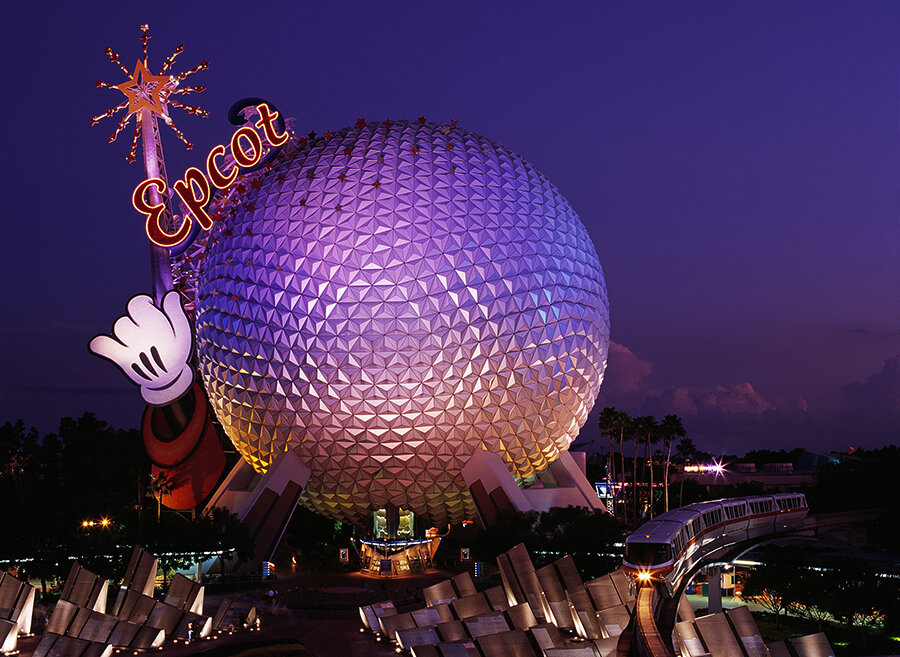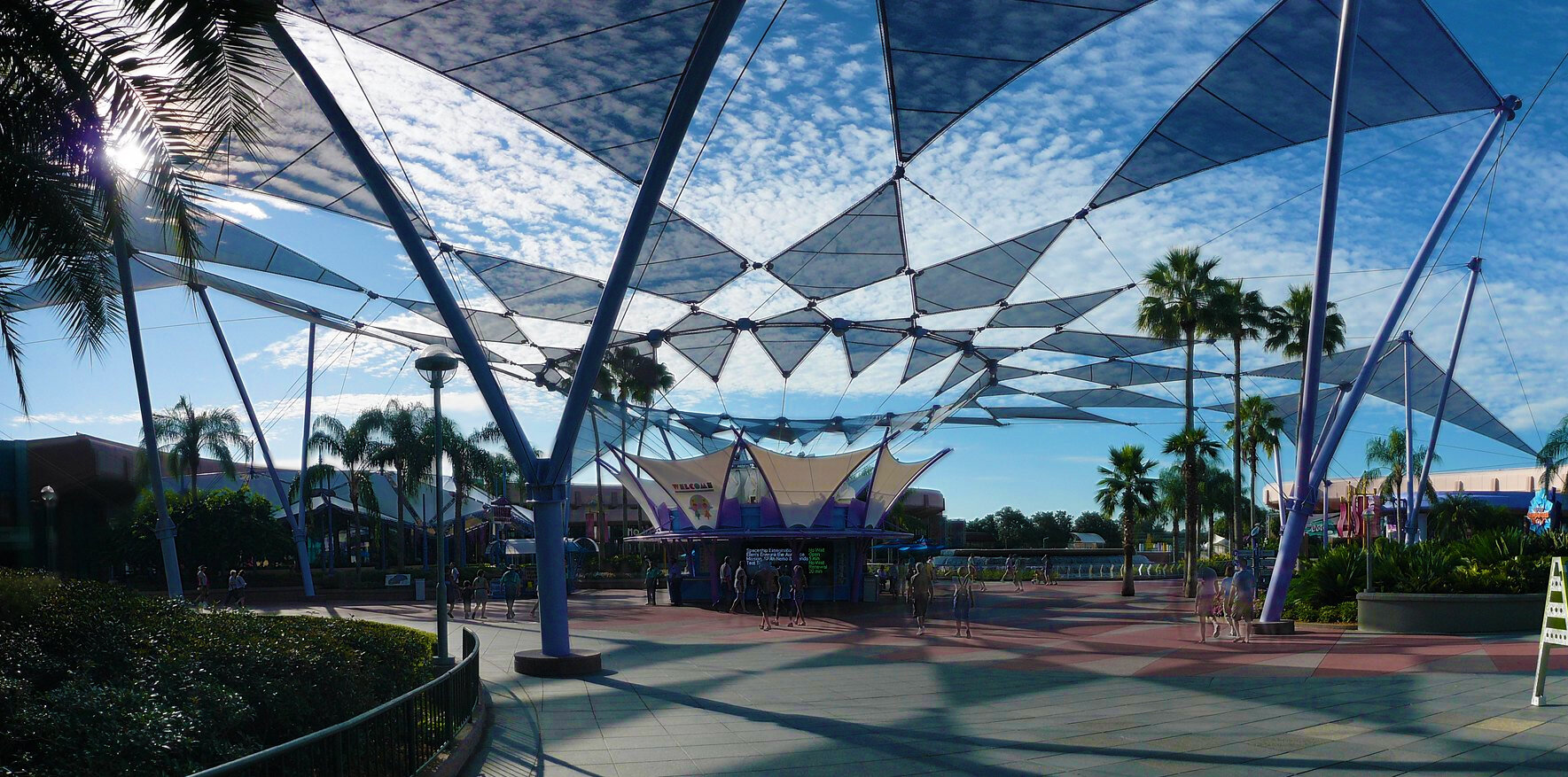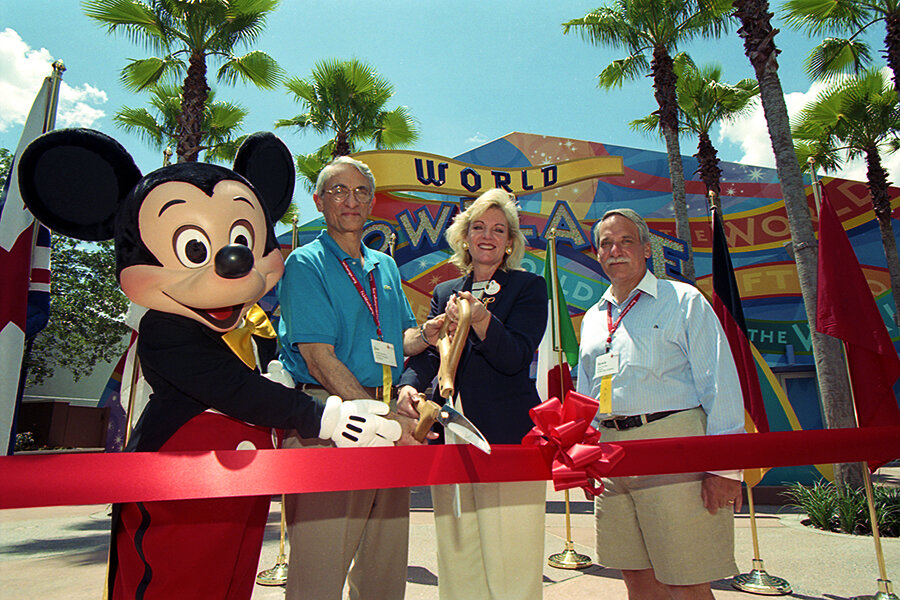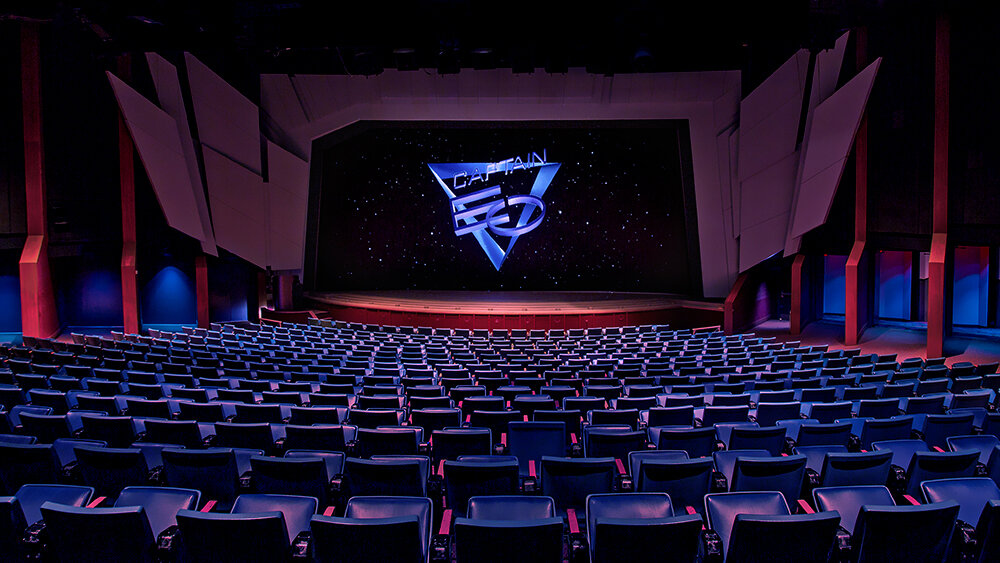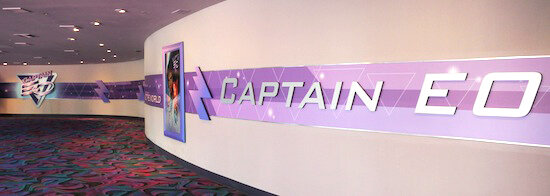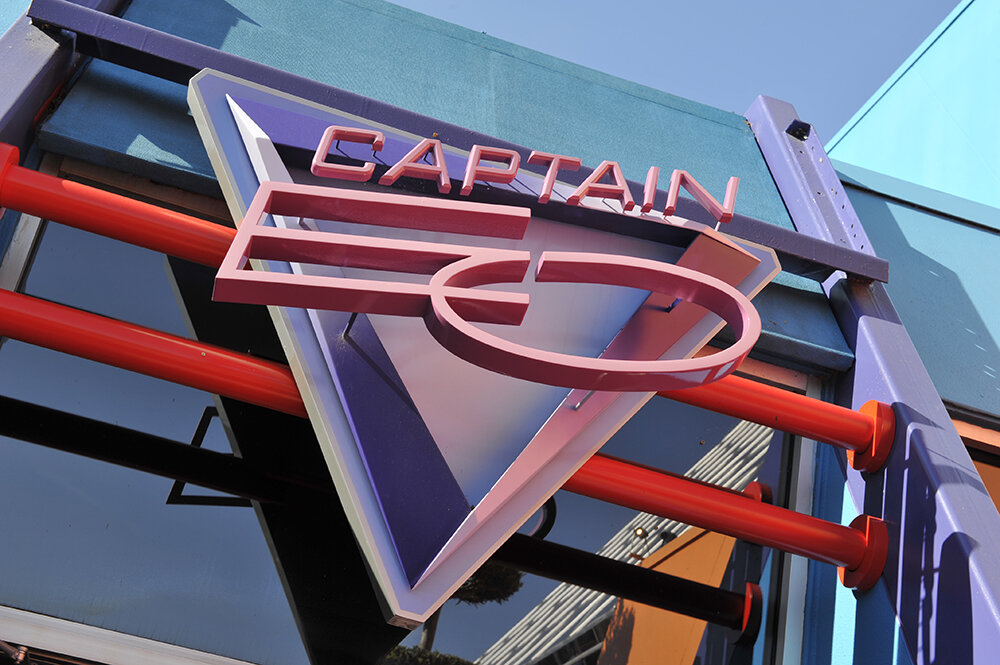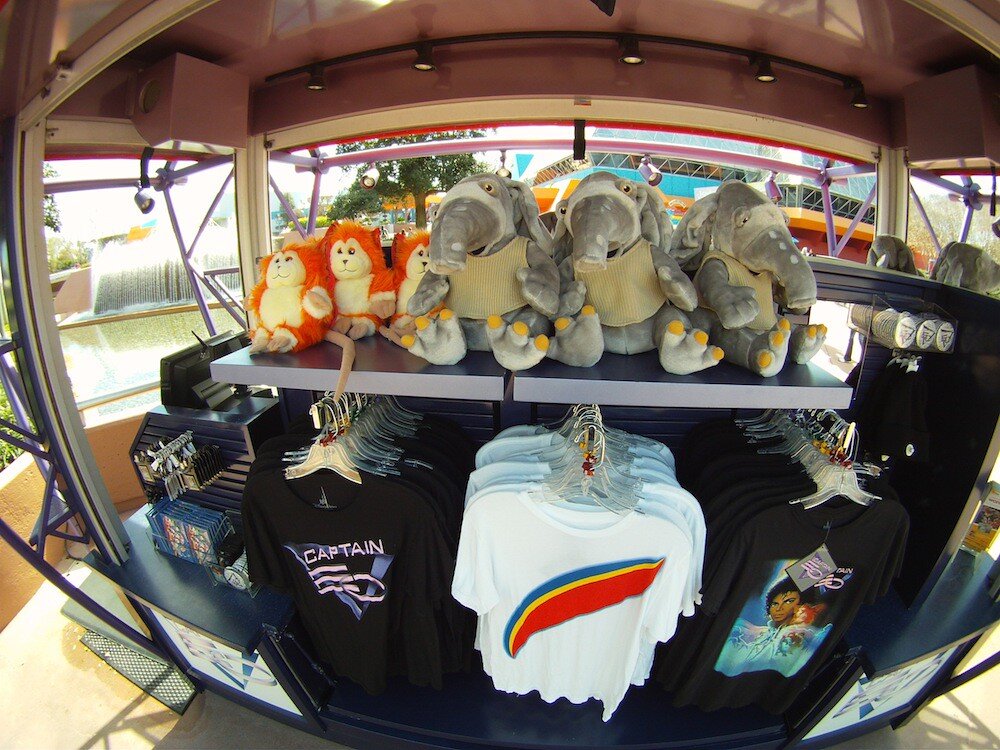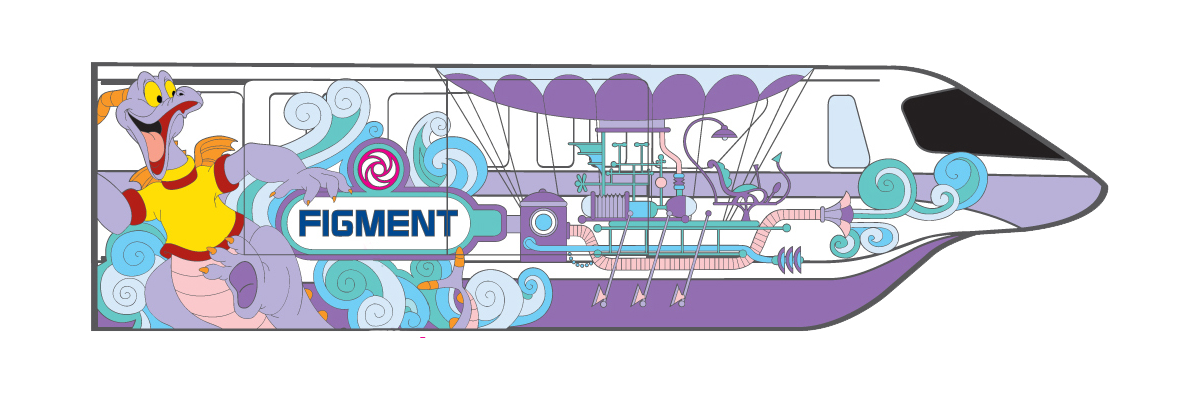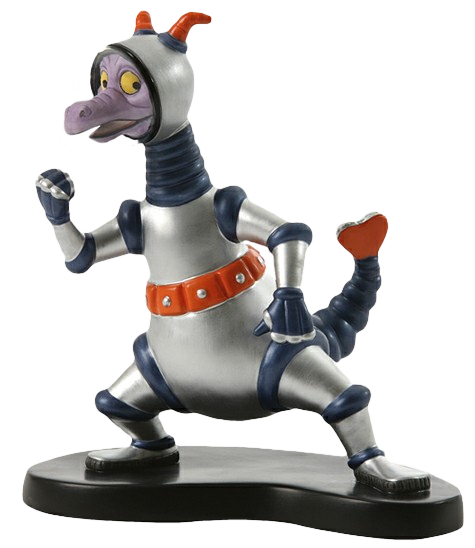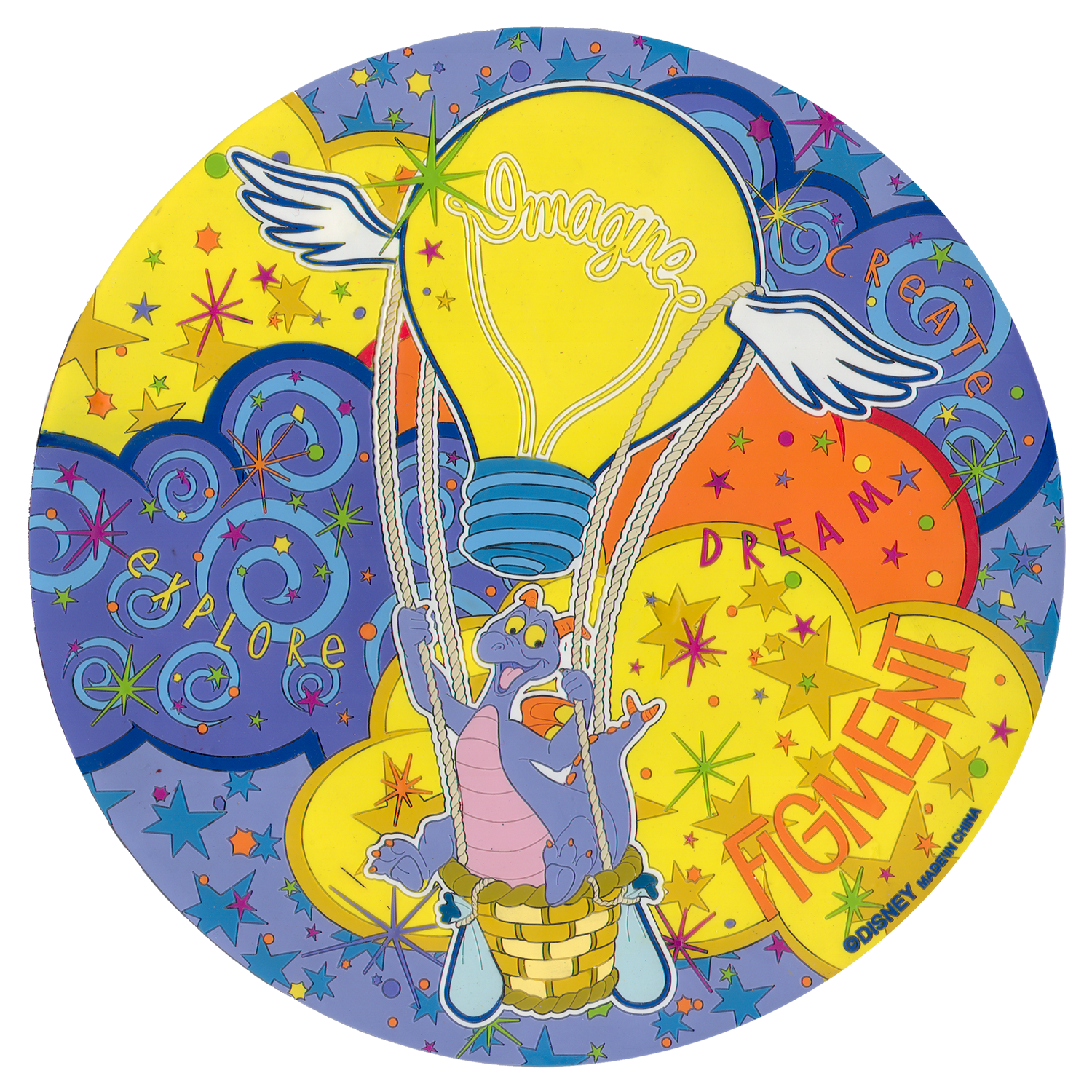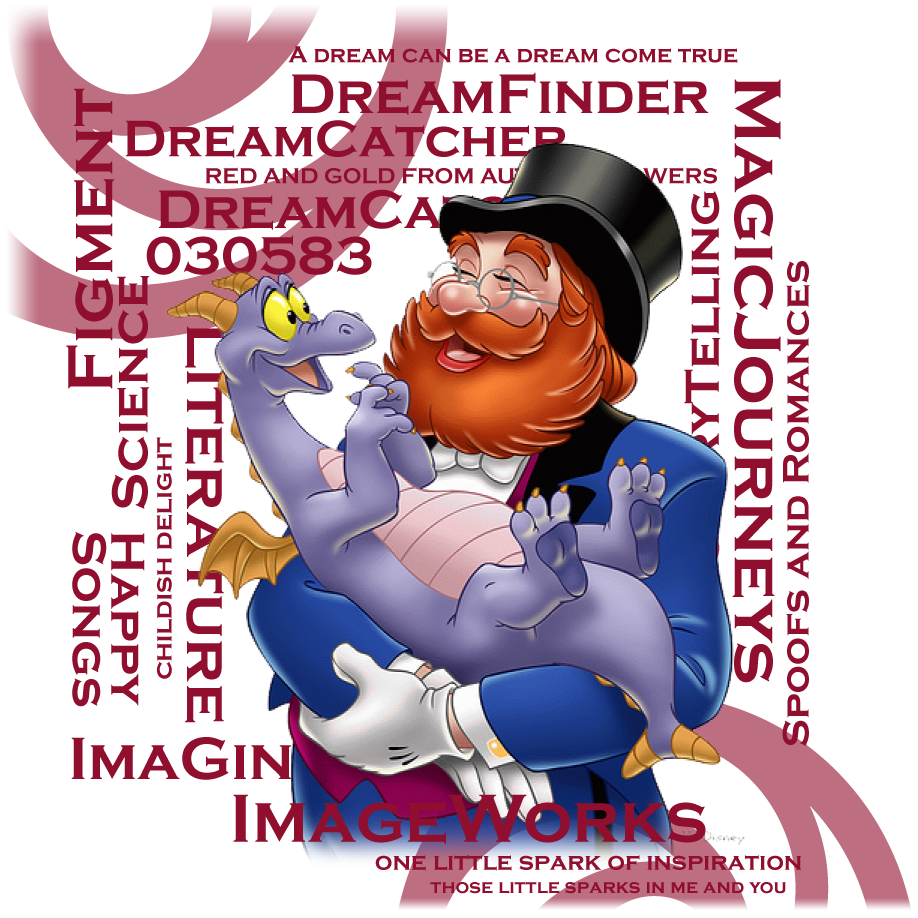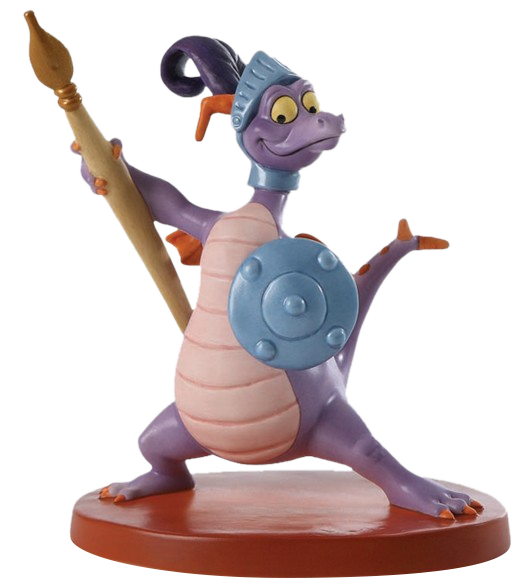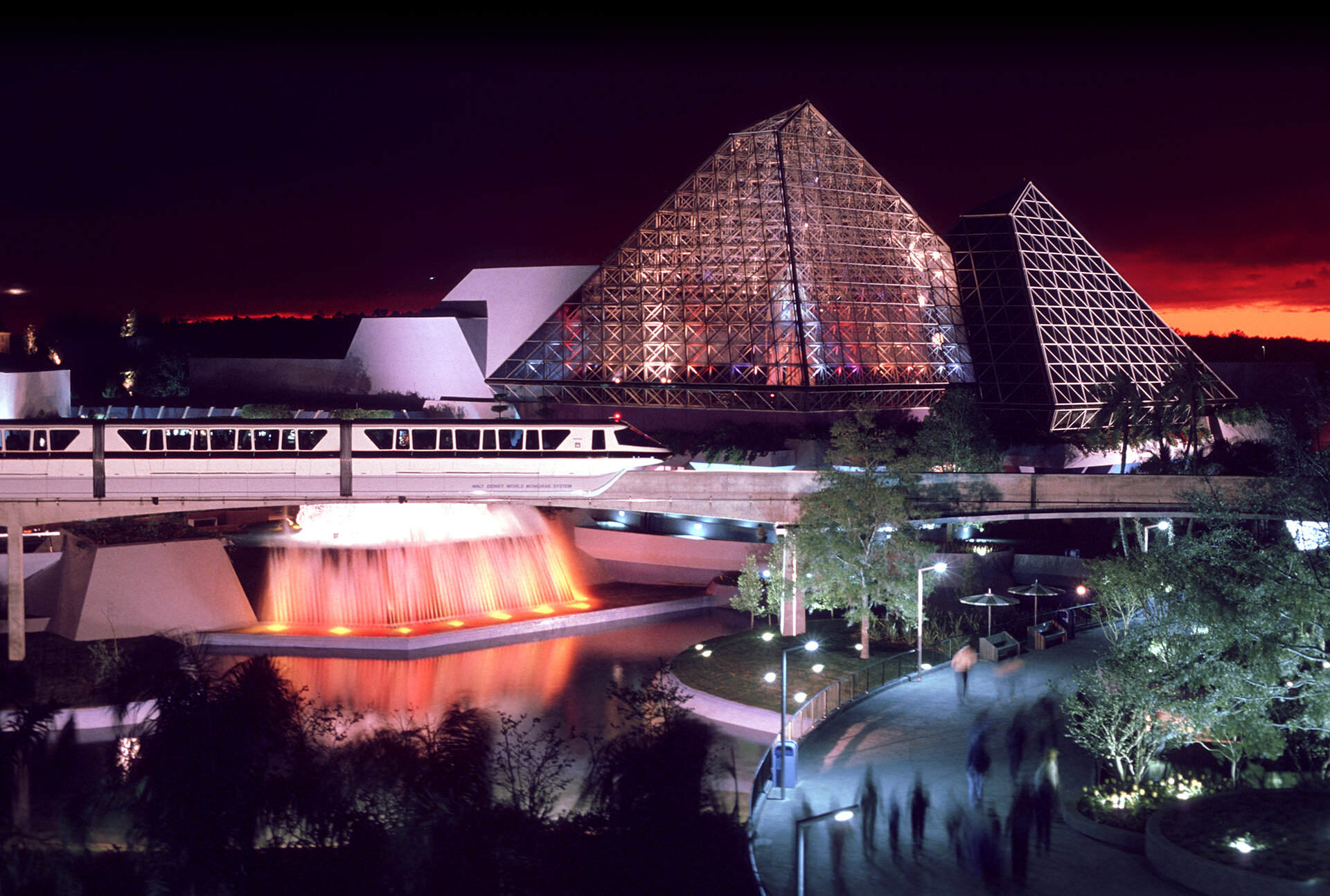GATHER, STORE, RE-COMBINE
A HISTORY OF IMAGINATION
PART IV
Returns,
Tributes &
Beyond
OUR STORY SO FAR… The whimsical Journey Into Imagination has transformed into the kinetic The Imagination Institute. The light-hearted antics of the Szalinski family have moved into the Magic Eye Theater as Honey, I shrunk the Audience. And at the turn of the millennium the former focal point of the pavilion and second most popular attraction in the park, Journey Into Imagination (the ride) has artificially dropped in attendance causing a dramatic overhaul of the entire attraction. Journey Into YOUR Imagination is underfunded and it’s designers are ill-equipped (and perhaps ill-experienced) to deal with the enormous pressure to deliver a quality attraction with an impossibly short deadline. The ride is destined to become the most notoriously inept attraction in the history of Epcot.
History Became Legend
Legend Became Myth
And Some Things that Should Not
Have Been Forgotten Were Lost
-Philippa Boyens
(The Lord of the Rings, Screenplay 1998)
Post-Millennium
The year is 2001 and Epcot has just experienced one of the most populous years in the park’s existence. As the confetti settles, the park that announced the “beginning of the 21st century” is now suffering a post-millennial hangover. The pomp and circumstance manifested by the many “temporary” structures created for the celebration are now decidedly awkward in both their appearance and subject matter. Thanks to a lack of demolition funds most of the architecture intended to only stand for a year would stay for quite awhile longer. (1)
The Millennium Celebration, necessitated that every available venue had to be used to absorb the high attendance of the fifteen-month campaign. As such any modifications, preventative maintenance, and future developments were put on hold. (2) In addition, the severity of Imagination complaints had been masked by guest's responses to the mostly positive Celebration. It wasn’t until the campaign was over that the cast at Epcot Guest Relations (and WDW Communications) was made fully aware of the public’s distain for the new Imagination ride. Fortunately, the attraction never had a strong ally in the upper echelons of the company, and even the slightest amount of negative feedback would cause the attraction to change. What was unexpected is the massive quantity of the negative comments that the new attraction received.
To the Disney aficionado, the complaints and reactions were a response to multiple factors on multiple levels. From a Macro perspective, the cycle of closing cherished attractions and replacing them with shorter less-immersive experiences at Epcot had grown more tiresome with each successive rehab. Even though the numbers for the attraction had diminished the original Journey was one of the most beloved experiences ever created for the park. The complete elimination of not just the ride but also its characters only helped to spur public outrage. The final factor was the overall concept for the YOUR Imagination attraction itself.
Analyzing the Aftermath
In Walt Disney Imagineering there is a concept called “Lessons Learned”. The program is a summation of the challenges and successes of each project after its completion. It’s a important communication tool to all current and future Imagineers as it provides them with techniques and processes to either reuse or (most importantly) to avoid making the same mistakes again. The following is not one of those the reports, but nevertheless does provide a dialog for determining the many “why”s of the project… "Journey Into YOUR Imagination" was an Omnimover-style attraction, as such the ride is about what you're looking at or going through. In Part 3, it was revealed that "YOUR Imagination" and "Test Track" share the same designers and many of the same plot points. "Test Track" functions on an inverse philosophy where your ride vehicle is the main focus of the experience. As such, scenic design and decoration are kept minimal at best. (Not much to look at.) "Test Track" is able to get away with this for two reasons. First, the theme of an automotive test facility does allow for this to happen. Second, is the aforementioned Victory Lap that ends the attraction on a high note, in essence, making-up for any short comings in the overall ride experience. "YOUR Imagination" inherits none of these factors. The storyline is focused tour the Open House of the Imagination Institute. Such an institute simply would not have that amount of dead space in between its many laboratories. Furthermore, Omnimovers-style attractions are most successful when they are designed to be as cinematic as possible. (3) In the case of YOUR Imagination, there was no such immersiveness, even with what little sets they had the content and subject matter was so mundane that it hardly seemed worthy to (literally) cast a spotlight on. Lastly, and biggest of all missteps was the “Imagination Scanner”. I’m sure that some thought that the gag was cute, but on even one repeated visit the whole premise falls apart. (Editor’s Note #1) From the guest’s perspective, the ride insults you and your intelligence from the first scene. The brain scan both visually and audibly reveals you to be empty headed with no imagination what so ever. (4) Although intended to be funny, this gag permeates with the whole experience and therefore becomes a serious part of the attraction’s narrative. Even more incredulous is that after observing some century–old illusions guests’ imaginations receive a megadose of creativity that sends the Imagination Scanner “to the limit”. Although it may not be part of the Sklar pinned Mickey’s Ten Commandments, I’m fairly positive that “Not Insulting Your Audience” is implied in there somewhere.
The Return of the Dragon
By the middle of 2001 the decision was made to fix the Imagination situation. Once again, timing and finances would prove to be the biggest hurdles in the re-interpretation of the ride. Kodak was both unable and (rightfully so) unwilling to provide any more funds. Disney did not press the issue mostly because they were already on thin ice with several sponsors. From Kodak’s perspective, they were promised a “must-see” attraction and instead got quite the opposite. This was Disney’s issue to fix. A retooling of the attraction was developed and Journey Into YOUR Imagination closed on October 8th, 2001. The attraction existed for exactly two years and seven days. The timing of this rehab could not have been worse, less than a month before the unthinkable happened and all of Walt Disney World closed for the second time in its history, and the first time because of terrorism. The 9/11 attacks, rippled through virtually all economic centers of the country. One of the hardest hit was tourism and the effects of an attack a thousand miles away were extremely direct. (5) Once again, budgets were extremely low and Imagination’s quick fix was to be done on a budget of less than Eight Million Dollars.
Eight million dollars, to put that in perspective; it’s the theme park equivalent of remodeling an entire 2,000 square-foot home (new furniture, lighting, paint, and art work) for a little over $400 dollars!
Journey Into Imagination with Figment
It has been said that “Art thrives on restrictions”, and considering the pressures that the team was under, the “new” attraction could be considered quite impressive. At this point the public had spoken, and integrating Figment in any and all ways possible was the primary (if not the only) objective. During the two years of YOUR Imagination, more than a dozen of the ride’s animatronic Figments became artifact displays scattered in several offices around property. The first order of business was to call these little guys home and most of these Figments would soon be reinstated into active-duty. The attraction itself would be significantly lighter in tone and combine the light-comedy of Eric Idle’s Dr. Nigel Channing and a rather mischievous version of Figment. The redesign of the attraction (by necessity) would have to be almost purely aesthetic. The conversion process would be even shorter than the previous attraction from 356 to a mere 236 days. Journey Into Imagination with Figment is more of a descriptive term than a title. But, fully describes exactly what the conversion set out to accomplish. In hindsight, the re-tooling of the attraction’s storyline is entirely reactionary. The “new” attraction would still be a tour of the Imagination Institute but instead of going through illusionary tableaus, the attraction would now focus on the five senses.
The show designers would also bring back “One Little Spark” as both the song and underscore. The song itself would be re-orchestrated and rearranged to fit the confines of the existing ride structure. In addition, the Sherman Brothers were also brought back-in to write a few new verses of the song. Unfortunately, Figment’s original voice, Billy Barty had passed away on December 23, 2000. Dave Goelz, of Muppet’s Fame, was brought-in to provide Figment with a new voice. The re-tooled attraction also would feature a more unified color scheme as show set designer, Alex Wright stated…
"Color will play a key role in the new attraction. Each of the sensory labs has its own color scheme now. The smell lab is green, the sight lab is yellow and the sound lab is blue. And, even though you don’t really go into them, [you’ll see that] the taste lab is orange and the touch [lab] is red. […] Everything Figment touches turns to purple.”
WDI Vice-President and Show Producer, Kathy Mangum added...
Even though we keep the building the same — the ride track, the facility walls and certain set pieces are reused — I think the tone and the attitude is going to be so different that you won’t recognize them from before. […] The ride path is essentially the same, but there’s one thing that we really changed. Now, we stop the vehicles in each scene so you can watch something happening and then move on. We’re telling a linear story, and that’s really hard to do with a long train of cars. What guests in the front car see is not what guests in the back car are going to see. So, by stopping, you get this kind of little theater. When the scene’s over, we turn you back loose to move on to the next scene. I think that this was a really big breakthrough for us in trying to figure out how to tell the story with Figment.
SCENE 1
—
Imagination Institute Lobby
As we enter the "Imagination!" Pavilion we find ourselves in the Imagination Institute lobby where we pass the Reception Desk and Directory listing the many Sensory Labs of the Institute. And because today is an Open House we can forgo checking-in and proceed straight to any and all labs of the Institute.
SCENE 2
—
Senior Scientist Corridor
Just past the reception area are a few of the senior most scientists of the Institute. Wayne Szalinski’s office door is a blaze with pink and blue lights with silhouetted lab equipment. Professor Phillip Brainard office is the scene of a music-thumping Mambo Party for flubber. Dr. Nigel Channing office must be flooded with calls as we hear multitude of telephones ringing from inside his closed office door.
As we continue up a ramp to the loading area for the Sensory Labs, we notice large overhead screens featuring variations of the Imagination Institute with a tiny purple dragon that interacts with the “stationary” logos overhead.
SCENE 3
—
Load Area
The long corridor of offices eventually opens up to the latest invention of Wayne Szalinski; The Imagination Institute Tour Tram that conveys Open House guest to the many Labs of the Institute.
SCENE 4
—
Sensory Lab Entrance
After boarding our bright red Tour Tram we are introduced to our host Dr. Nigel Channing who explains that imagination works best controlled. And the Sensory Labs are used to further study the five senses and how they are used to process information.
SCENE 5
—
The Sound Lab
This small space covered in sound-proofing black foam, with speakers in every conceivable location, from the ceiling, to the floor every inch of space is developed for maximum sound perfection. Just as Dr. Channing is about to demonstrated the power of sound, Figment pops-up to disrupt the Doctor’s train-of-thought. To which Figment corrects him by replying that his train is, in fact, right on track. And it’s coming our way. The Room begins to shake and the thunderous train with its blaring whistle seemingly races through the room, complete with a blast of wind as it travels by. (6) The scene concludes with the first verse of the new version of ‘One Little Spark”…
For ev’ry sound your ears are hearing,
a thousand thoughts can start appearing
And each of us imagines different things
From just a sound, your mind has wings
SCENE 6
—
The Sight Lab
Our tour vehicle rolls past The Sound Lab and into the colorfully appointed Sight Lab where the walls are covered with framed pictures of some of the greatest optical illusions ever created. The most dominant of all these is a very large Eye Chart, where Figment is seen sneaking behind the letters and eventually rearranging them to spell his own name! Dr. Channing wanted this to be a simple Eye Exam, but Figment argues, “Sure, you can see with your eyes, but imagine what you could see if you used your imagination!” Then Figment invites us to sing along by following “the bouncing Figment”…
One spark of light can light your fancy
Your mind sees more than your eyes can see
Your sense of sight can make your fancy fly
There’s more to sight, than meets the eye
SCENE 7
—
The Smell Lab
From Sight to Smell, we travel into a small space filled with tanks and tubes loaded with scents of every kind. Our tour trams then stop in front of a massive tank with cannons directly in front of us. Just as a lovely scent is released, Figment takes over the tank converting it into an enormous slot machine where any scent could come out. The dials spin to a stop and it appears as if our luck as run out, for Figment is now seen in a skunk suit and sprays us with the highly nocuous odor! Customarily, the scene ends with another set of verses to “One Little Spark”…
One awful whiff can send you reeling
One lovely sniff can be appealing
Your mind defines what enters through your nose
That’s how you tell a skunk is not a rose
SCENE 8
—
The Detour
Leaving the Scent Lab (and Its stench) as quickly as possible we make our way past several other labs in which serious experiments are in process for things like Dreams and Laughing. We make our way to the Touch and Taste Labs but before entering Dr. Channing has become rather troubled at how Figment and turned the tour upside-down. “Upside-Down!? That’s the Best Idea you’ve Had all Day” exclaims Figment who transforms the scene into one of the bright colors of black light.
SCENE 9
—
Figment’s Open House
With just a spark of inspiration
I’ve made my house an innovation
Imagination can really clown around
Make down side up, and upside down
Figment’s house normal in every way, normal if you’re an Imaginative Figment!
In the garage his truck is filled with oversized paint brushes. In the living room, the TV is on the Figment Channel. From the Bathroom to the Kitchen and all points in between the entire house is an extension of the little purple dragon. Pots & Pans, Wallpaper and Oven Mitts everything is perfectly “fig-a-fied’.
SCENE 10
—
Figment’s Short Cut
After we tour Figment’s house the up-side down world must be put right-side up. In this completely dark environment, Figment’s illuminated footprints spiral around the tour tram vehicle on his way back to the Institute. By this time, Dr. Channing has come around to Figment’s way of thinking. “Well if you can't beat 'em, join 'em!” he states and joins Figment in a duet of the next verses of the “One Little Spark” song.
We all have sparks, imaginations
That’s how our minds, create creations
We set them free, and oh, what they can do
Those magic sparks from me and you
SCENE 11
—
The Sky’s the Limit Finale
At this point, the tour concludes in a small computer filled environment where a much more cheerful Dr. Channing rejoins us (via video screen) and retracts his opening thesis by saying “And so, as you can plainly see, imagination works best when it is set free!” “You said it, Doc! Imagination is a blast!” Figment yells, and with that the room explodes in a purple light and then explains into a vast colorful room where several Figments are seen doing a multitude of things. From Hang Gliding to painting a master piece from constructing a sign to performing a puppet show, no matter what they’re doing they all join in the chorus…
Imagination, imagination
A dream can be a dream come true
With just one Spark in Me and You!
From here our vehicle leaves the Figments and continues into the vastness of outer space with purple fiber optic stars covering the area. The last thing we see is a Spaceman Figment on top of a ringed-moon hitchhiking his way through the galaxy. Above him, is the man-in-the-moon or rather a Dr. Channing-in-the-moon happily singing the last chords of “One Little Spark”.
The opening of Journey Into Imagination with Figment was handled very quietly with little to no fanfare. The marketing of this event (if you can use that word) was especially blunt. The whole reopening was focused on the tagline “Figment’s Back!” this slogan was used on T-shirts and other media. The whole non-event was analogous to an extremely large newspaper retraction. Nonetheless, this was an awesome statement and friends of Figment the world over cheered that after years of pursing the masses Disney’s neglected core audience was being listened too. The overall reaction was in essence “It’s a lot better than what we got, but less than what we had”. The final judgment on Journey Into Imagination with Figment, is a highly complex one. It is important to consider all factors. From a historical perspective, it is unique as it is one of the first uses of what could be called “Guerilla Imagineering” (7) No Budget, No time, only armed with your creativity to get you through. Considering this the ride is very well done. On the other hand, it is designed as merely a stopgap to appease Figment lovers and present a decent attraction until time and funding provide a more spectacular replacement.
A Question of Character
The Tale of Two Figments
It is often true, our perceptions of any character are largely determined by the way they are depicted. In the musical, Wicked, we are introduced to the sensitive and misunderstood “Elphaba”. Meanwhile, in the Wizard of Oz the “Wicked Witch of the West” is portrayed as both evil and scary. Much in the same way our beloved little Figment has been has been cast in a negative light. (8)
One of the biggest complaints I receive about the current Imagination ride is that Figment has become extremely annoying. Meanwhile, if you speak to anyone 25 or older, they would give you a far different description. I believe both points are accurate. To the over 25 set, Figment is described as Adorable, Fun-Loving, Energetic, and of course Imaginative. However, if you speak to those under 25 (or those who haven’t been blessed to take the original Journey) they find him to be, basically, the Epcot equivalent of Stitch without the charm. This dichotomy exists because of the two completely different versions of character.
In the original attraction Figment is created in the opening scene therefore we know him “from birth” and are more inclined in love him. From there, he and Dreamfinder take us into some wonderful environments where we see Figment discovering the world around him. From creating rainbows and staving-off monsters to acting in plays and becoming a movie star, Figment is seen doing anything and everything. It’s also interesting to see what he is not doing; interacting with the audience. (9) (But that’s a long story for another time.)
In the current attraction, Figment is in your face (and up your noise) for most of the ride and spends most of his time interrupting rather than enhancing the Institute Tour. And if that wasn’t annoying enough the tour ends with a BLAST! That typically scares young children (who technically are the attraction’s target audience).
There is also the sidekick perspective. (10) In both versions of the ride (that contain Figment) he is the sidekick for a human character.The relationships between Figment and both men are vastly different. With Dreamfinder, Figment is his creation, his child and they have a very loving relationship. Dreamfinder encourages and develops Figment’s creativity. They both complement each other very well. Figment exhibits Right-Brain characteristics while Dreamfinder is more Left-Brain oriented. In the case of Dr. Nigel Channing, he considers Figment to be somewhat of a nuisance and therefore so does the audience. Figment and Nigel argue throughout the attraction about what the best use of Imagination is. When they finally agree the ride is over and there is very little in the way of reconciliation.
Ultimately, our little Figment has been the victim of a series of circumstances. Not the least of which is the lack of time (and proper budget) for his return to the pavilion. The changes in Figment’s personality are an example for maintaining “Character Integrity,” and how difficult adapting an established character can be. As Tony Baxter put it (commenting on the current version) “You can meet Figment but you don’t know who he is.”
Journeys into Imagination
In general, one should never compare different things to each other. The Disneyland Verses Magic Kingdom debate will continue for as long as both parks exist. The results of comparison are pirmarily negative and as such are unproductive. However, comparing approaches to different subject matter is extremely interesting as in the 1958 film “4 Artists Paint 1 Tree”. In much the same way, it’s fascinating to examine the differences between the three very different interpretations of the abstract concept of Imagination. In the most recent version, (with Figment) the subject is an exploration of how we absorb stimuli. With the five senses, we take in a lot of information and then GATHER it for future use. In the second version, (YOUR Imagination) those senses are revealed to be at times deceiving. In a way, we STORE information for the final brain scan at the end of the ride. Finally, the original Journey shows us how we can RE-COMBINE many different stimuli to come up with something new. This is the biggest difference between the versions of Imagination, the second and third storylines are focus on Perception where as the original version is concerned with Application and exciting prospects of taking your imagination to the next level by bringing the sparks of creativity into real world!
The Image Works as of 2006
ABANDONED IN STATE
The After-Life of Image Works
The Imagination Pavilion has become one of enormous historical contradictions. For as much change has occurred on the pavilion’s first floor, the story is quite different on the second. The mere existence of the Image Works is one that has fascinated theme park enthusiasts for the past decade. The fact that the space has existed frozen-in-time that also was an Opening Day attraction of the park has become a source of intrigue that is equally (and unusually) interesting and morbid.
Whenever a Disney facility closes for a period of more than six months OSHA dictates that the structure must be brought up to current building codes. The part of this code that concerns Image Works is one of wheelchair accessibility. For an exhibit of its size and occupancy, a single use elevator is not appropriate for the needs of 21st century structures. The transition between the original and second versions far exceeded time limits and the cost to make major improvements to the existing space was cost prohibitive. (11) As a result, its existence was as architecturally concealed as possible. One of its two escalators was caged and the other was walled-off entirely. The central elevator and spiral staircase was cleverly masked by with non-descript banners and merchandise displays to prevent easy passage to the second floor.
Soon after the space was closed any and all useable equipment (monitors, touch screens and other electronics) was removed to be used in other exhibits around property. And so for the next several years the space was used sparingly for conventions, internal company meetings, and has been a long time stop on the “Undiscovered Future World Tour”. In 2006, a large amount of the space received slight refreshment as a part of the test for the Kim Possible Experience where your last mission took place inside The Image Works. During this time, there were also a few architectural adjustments made to the main exhibit space. Walls were constructed enclosing the "Making Faces" and "School of Drama" and (as of this writing) have become a monitored storage area for Epcot’s more valuable electronic equipment. Over time, only a few original props have wound-up “missing” from the exhibit. The Electronic Philharmonic has been stripped of its Orchestra, and the pin screen tables are constantly “roaming” around the exhibit and occasionally “make appearances” in the atrium. Most recently, Figment’s Coloring Book (aka Pyramid B) has been used for storing many of the displays and signage for the Honey, I shrunk the Audience attraction while its future return hangs in the balance.
The Image Works is one of the few remaining abandoned spaces in Disney Theme Park History. On a personal note, I’ve been “up there” several times in the course of its now ten-year hibernation. And every time I do so, I always feel like some ROV exploring the decks of the Disney version of Titanic, and to spite its neglect the second floor of Imagination is remarkably well preserved. In recounting its history one is reminded of another charming attraction that was brought back to life after decades of “sleep” The Sleeping Beauty Castle Walk-Through suffered much the same fate and has the same limitations, so one can only hope that Aurora’s prince and Imagination’s creator, Tony Baxter will breathe life into the void once again.
The Image Works as of 2010
Tribute to a Captain
In 2009 the tragic loss of entertainer Michael Jackson sparked an enormous amount of interest in all things Jackson. To the Disney universe, this naturally lend to much discussion and coverage of the all but forgotten 3D Space Fantasy, Captain EO. There were multiple articles written about the groundbreaking film from all angles. (As was previously discussed at E82) there were even articles written about the films that were Not Made. In addition, anything associated with MJ was selling in record numbers including the motion picture profiling his incomplete concert for the UK which was to once again feature the latest in 3D effects. The Walt Disney Company took notice of all this and fans of Captain EO cried out for the film to be shown once more. Disneyland has always been home to temporary (albeit expensive) spectacles. It’s dynamic as a “local theme park” allows attractions and shows to be replaced or refurbished with little to no guest complaints. Consequently, the park often serves as a test lab for Imagineers and Park Operators to experiment with new offerings with little to no risk. As such it was decided to bring Captain EO back to the park for an indefinite period of time. The attendance numbers for the attraction were significantly higher than any of those seen for Honey, I shrunk the Audience, and the guest satisfaction numbers were off the charts. In six months time, the Tokyo and Paris parks had already made plans to join the Captain’s crew and finally Walt Disney World Management decided to join the party by committing to bring the “Rag Tag Band” to its original home at Epcot. The conversion from the Imagination Institute to EO was handled very quickly and much of the Institute’s props and and wall décor was carefully stored (upstairs in The Image Works) while the company is unsure of the attraction’s final destination.
A Rag Tag Revival
The 2009 film Avatar showcased the latest digital 3D techniques that were the culmination of five years of experimentation. The development of Triple Frame Rate with alternating shutter apertures had eliminated nearly all of the problems and headaches (pun intended) associated with 3D viewing. In sharp contrast was the antiquated screenings of Captain EO a year later. In all cases, the longevity was (and still is) in question. Therefore, company executives and accountants were largely concerned with keeping the cost of this impromptu revival down. Consequently, the conversions of all shows did not fully restore all of the effects found in the original presentations. The lasers of the space chase, the spotlights of the crash, and the mirror ball transformation were among the effects that did not return. To be completely fair, the new film did incorporate the elevating platform and LED Lighting from HISTA. However, the theater also retained the custom stage frame from the Imagination Institute presentation cutting off the edges of Captain EO as well as a noticeably distracting 45° angle on the upper Left side. (12)
The Trouble with Stated Nostalgia
Officially, the only “Captain EO Tribute” is found at Disneyland with all other shows in the revived franchise simply stated as “Captain EO”. This minor title change is important because when the original Disneyland show reopened the preshow was displayed with a narrative that explicitly states the historical context of the presentation. California is where the term Kitsch was invented and hence it’s expected that any Disneyland-style park would join-in the local culture. The same cannot be said for the Epcot presentation. When it opened in 1986, the EPCOT Center Version of the film was preceded by a Kodak photo presentation set to the song “Capture a Smile”. A lighthearted Song/Pre-show that had absolutely nothing to do with the main attraction itself. Once the presentation concluded a Cast Member would make a brief spiel, then curtains would retract and the theater doors open. This is also when the much sought-after Pre-show space music would begin. The dark, mysterious, and magical music of James Horner was echoed in the atmosphere of the theater itself and was primary lit by starlight. This atmosphere perfectly set the tone of the film’s opening moments. It is also important to note that the film itself used state-of-the-art projection technologies and numerous in-theater effects that created an extremely immersive experience of the film. In sharp contrast, is the 2010 presentation wherein the film has the original Disneyland pre-show filled with the worst of 1980s clichés. From the leg warmers, to the big hair and from the dancers to the heavily mustached Imagineers this film portrays almost nothing about the craftsman ship and artistry found in the film it attempts to document. This might sound a bit harsh, but during the pre-show nearly everyone today is heard laughing for all the wrong reasons. In addition, the historical context announcements appear to excuse the attraction for its short-comings before the film even begins seemingly setting-up the audience for disappointment with the hope that by lowering initial expectations they will increase guest satisfaction for a surprisingly good show in the end. It is in this historian’s opinion that no attraction should either excuse itself for its age nor be excused because of if it. Walt Disney himself never intended his parks to showcase themselves for their own intrinsic historical value. Nor is it ever appropriate for an attraction or theme park to exhibit anything less than high-quality simply because of its age. At the time of this writing, Tokyo Disneyland has changed Captain EO’s presentation from a “Temporary” to “Permanent” Attraction. So one can only hope that the Oriental Land Company will fund a comprehensive film restoration and digitization, that one day will spread to all four corners of the Captain’s Changed World.
An Active Retirement
The existence of the 3rd incarnation of the Journey into Imagination is something of a milestone in the history of theme park attractions. Although slight modifications had occurred over guest feedback, a complete restructuring due to guest demands simply did not happen until the events of 2002. (13) It is also the first time in Walt Disney World history where it’s much neglected (inner most) core audience was listened too. (14)
In a few short years, the almost unthinkable occurred. Following the then recently established trend of “Retro” the name “EPCOT Center” was once again seen on current in park merchandise. These items were quickly noticed by Classic Epcot fans and were soon flying off the shelves. Then more products were created and still more are created to this day with a new t-shirt appearing roughly every six months. One in particular that stirred a large amount of discussion was a one in which Dreamfinder and Figment where prominently featured prompting speculation about the character’s return. Disney Theme Park Merchandising spends more time and effort getting to know what people will buy than any division of the company. It is a business in its purest form and Product Developers are keenly aware of the spending power that Classic EPCOT Center merchandise holds. For almost a decade, Figment and Dreamfinder have been the focal point of Pin Celebrations, limited edition sculptures, and artwork. If it’s an event that is in anyway associated with Walt Disney World’s second theme park it WILL have Dreamfinder and figment in there somewhere.
This unusual attention given to a retired character has sparked (no pun intend) debate that reincorporating the character is imminent. Unfortunately, there is no evidence to support this. Product Development (PD) and Walt Disney Imagineering (WDI) work together only during the last phase of a new attractions development. PD works 18 months ahead and WDI works 3 to 5 years before that. If there was to be a new version of Imagination, its merchandise would appear just a few days before reopening the pavilion.
In the past year, there have been several events that have brought a new awareness to and respect for classic Walt Disney World characters and locations. (15) Just a few short weeks ago, D23 celebrated the upcoming 40th Birthday of the Magic Kingdom (and ultimately Walt Disney World). At this event it was obvious that Epcot was the biggest focal point for those in attendance. At the closing of this Weekend-long event was a musical tribute to the songs of the Sherman Brothers. The concert-like performance (appropriately titled “Magic Journeys: A flight of fancy through 40 years of Walt Disney World’s Musical Memories”) transitioned from the Sherman’s animated work to the parks and finally settled on EPCOT Center Classics. When it came to “One Little Spark” THE Dreamfinder, Ron Schneider, appeared on stage as the character for the first time in well over decade. The reaction to this surprise appearance was ecstatic to say the least. Many who were in attendance said that he received “a reception similar to Elvis.” One can only hope that with such an overwhelming response a return of this much beloved character will occur sometime soon.
BEYOND INFINITE
Tomorrow's Imagination
The complete history of the Imagination pavilion has been one filled with success and conflict. In many ways, the history of the pavilion directly mirrors the history of Imagineering itself. (16) The epic scale and lavish productions of a generation ago have developed into timely, straight-forward attractions with plots that are easy enough for a five-year-old to grasp. It also appears that the past is repeating itself with classical storytelling on the rise. (17) Although it’s impossible to determine the next course in Imagination’s evolution, let’s speculate about what a future Journey could be like …
It is the middle of the second decade of the new millennium. A new Fantasyland has renewed the collective consciousness’ faith in the (stateside) Art of Imagineering. As a result, Imagineering has now directed its attention from lands of fantasy to the World of the Future. The newest draw for the park is the Return of a Classic updated for the 21st century. It has become the one of the biggest draws for Epcot and, thanks to its massive OHRC, the Ride is the second most visited attraction in the park (second only to Spaceship Earth). Because of its lower wait-times and amazing show quality, it has also surpassed Soarin’ in guest satisfaction.
JOURNEY INTO IMAGINATION
The Quest for Dreamfinder
The pavilion looks more fanciful than ever. The lower half of the building has an extremely familiar color scheme with both a literal and figurative twist, and (thanks to a recent cleaning) the glass pyramids shine so bright that even on a cloudy day it becomes necessary to wear sunglasses to observe the structure.Once inside, the original lobby has been restored to its former glory, as in the days of the original Journey. The Toshi Muto murals on both the ceiling and the walls have been lovingly recreated with updated color schemes and iridescent painting effects. The load mural depicts the first Journey with amazing detail and depictions of Figment and Dreamfinder more “on-model” than the original.
Proceeding through the circular queue, we pass through a new version of the Rainbow Corridor. Its neon rings are larger and more vibrant than ever before as the bands light-up they also scintillate with swirling light patterns racing to end of the tunnel accented with the faint sound of Figment’s laughter in the distance.
At the end of the Rainbow Corridor is the load area, a small darkened space illuminated only by stars and the glow of the corridor. It is here where we board paint pots, (not dissimilar to Pooh’s Hunny Hunt Pots) (18) and we take-off for our adventure into the many lands of Imagination. Well, maybe “lands” is inaccurate for our quest begins in the vastness of a universe.
Shortly after departing, we join Figment in the pilot seat of a sleek updated version of the Dreamcatcher, (now renamed the Sparkcatcher) were we learn that Dreamfinder is lost in his own Imagination and Figment needs our help to find him.
The first realm we visit is that of limitless technology, a realm where we see Figment in a lab coat (19) solving the mysteries of the universe on his 3-D holographic computer. Whether it be designing nanobots programmed to construct morphing physical structures or genetically engineering super intelligent beings nothing is impossible to our industrious little dragon.
Next, is the realm of unbelievable architecture. With Beautiful angles, impossible feats of engineering and indefinable styles, Figment is seen constructing the most incredible buildings and ingenious interiors. As we travel though this space the room even appears to change its shape! (20) The Walls and Ceiling move and rotate to become varied and fanciful environments constructed through the unity of mathematics and art.
From the marvels of architecture to the wonders of creation, through writing words composing music, and rendering worlds Figment can become the master of his own universe. But be careful, for your imagination can turn on you, as in this climatic scene where large literary creations close in on Figment. (21) Just as the darkness of the scene overtakes our little Figment, Dreamfinder flies in to save the day.
The darkest gives way to light and Dreamfinder has been found. In celebration of the happy event, we enter a large circular room; a fanciful land of white illuminated by colored light. A tribute to the original Walt Peregoy created “Arts” room of the original. Lit from above, below, inside and out the room practically spins with variegated color patterns and hovering in the center is Dreamfinder sitting atop his Dreamcatcher. The dirigible spins and undulates while collecting sparks around the room all the while keeping time with a particularly whimsical orchestration of “One Little Spark.”
In our final scene, we join Figment flying through stylized clouds. Suspended by a barely noticeable inverted Kuka Arm, he’s an amazingly versatile animatronic. And at the very end of our experience we see Figment fly into the arms of Dreamfinder not unlike the closing scene of Dumbo and his mother and equally as moving. This is also the first time two animatronics have performed in perfect unison ending the attraction, in both an emotional and stunning way.
After departure, we experience a new Image Works, featuring advances like gesture-controlled Magic Palettes with photorealistic textures and 3-D designs. Or the new Electronic Philharmonic where you can select the latest film scores from Pirates to TRON and control not only mixing of instruments but even the tempo of the music. Finally, Stepping Tones where your feet not only control the music, but can even select the genre. From 80’s Pop to Techno, Stepping Tones only gets better and better, for as the number of guests increases so does the tempo.
For all its interactive wonders, Image Works has now become the most elaborate of all interactive queues. Similar to Dumbo’s Big Top, all activities encircle a central queue for the new IMAX Real 3D presentation of Magic Journeys opening next year. A new film hosted by Dreamfinder and Figment, it combines the dreamy atmosphere of the original with coolness of Captain EO, and a hint HISTA fun. The film takes its audience on an unbounded trip through the limitless wonders of our world and other worlds to come.
And what of the Original Image Works? This space has become quite popular as the new Art of Imagineering. A cross between One Man’s Dream and the Blue Sky Cellar. The original architecture is still very much in use. You can walk through a lovingly restored Rainbow Corridor and the dark recesses of beyond are just perfect for exhibits featuring video and light effects. Figment’s Coloring Book has become a showcase for the latest projects including a new vision for World Showcase’s nighttime entertainment. But that’s a story for another time.
This is just one vision of what Tomorrow’s Imagination could be. The great thing about this attraction/pavilion is that it can be anything. This is also the biggest of all fears for Imagineers. How does one define the concept of imagination in the 21st Century? In the late 1970’s Tony Baxter, Kirk Wise, Barry Braverman, and several others came up with a concept explaining the of mechanics of the imagination process. Over the past 30 years, we have gathered a lot of sparks. We have self-contained highly-interactive walking animatronics. There are 3D high-definition multi-screen presentations coupled with vibrant color-changing LED effects and there are even ride vehicles that require no track or wire to guide them! Journey Into Imagination can (and should) be a place where All of these amazing technologies can be put to use. And if we’ve learned anything over the past two decades its that the best of all rehabs are those of enhancement and not reinvention. And the most well loved attractions and characters simply need better methods of telling their story. The public knows what it wants for Imagination and once funding is in place I can’t see Imagineering suffering the same oversight.
EPILOGUE
THE LEGACY OF IMAGINATION
As Walt Disney World approaches its 40th Birthday (with Epcot’s 30th soon to follow), there is a wealth of adoration for the charm of classic Walt Disney World Character’s and a wellspring of appreciation for the undated sophistication of decades-old designs. Captain EO (whatever its flaws) is back! The long concealed name EPCOT Center is celebrated once again. The Enchanted Tiki Room will soon be free of “Management”. And the Magic Kingdom (in comparison to her sisters) will at last be given a Fantasyland to be proud of. It seems like Walt Disney World is finally reaching maturity. Comfortable with what it was, and cautious to make the right decisions for its future. Whatever is done Today is done for Tomorrow. Longevity is the focus for Imagineering.
The original Journey has become an indelible fixture in the history of Epcot and ultimately Walt Disney World. From its whimsical style and prophetic visions of creativity in the 21st Century to its playful fountains and lighthearted tone in an otherwise very serious World of the Future, Journey Into Imagination has left a very big imprint on those lucky enough to visit during those first 15 years.
With the original Journey, Imagineering created the most impactful of all gestures. You’ve never been able to pet a Tiki Bird or flirt with a Pirate Auctioneer. The Hitchhiking Ghosts really don’t follow you home and Skippy, for all of his teleported adorableness, never did meet-n-greets. But from Day One (and even five months beforehand) you could experience the attraction and then interact with its characters. Long before Turtle Talk, you could have a conversation with Dreamfinder and Figment could play with your rainbow colored EPCOT Center baseball cap before Lucky the Dinosaur was engineered to do so. To Tomorrow’s Children, Dreamfinder & Figment were real! And if the events of the last month have proved anything The Marvelous Professor and his Baby Dragon are just as real today as they were decades ago.
It has been said Dreamfinder was based off of none other than Walt Disney himself, a childlike dreamer that worked toward bringing his creations to life. By extension Figment could also be seen as an upgrade from Mouse to a Dragon that is just as obsessed with creating as his creator. When looked at through this lens it’s no surprise that people are still remember the words to “One Little Spark” and stepping through a multi-colored portal of mesmerizing Neon Light.
Living Characters, Prophetically Interactive Exhibits, Leap-Frog Fountains and High-Speed 3D Films are among the many innovations that have made Journey Into Imagination a landmark in the history of themed entertainment. But it is history that is far from over and if the events of the last five years are any indication quick-fixes are becoming extinct. “Timely” has been replaced by “Timeless” and whatever the future holds I am sure that the Next Journey will surpass everyone’s expectations.
Editor's Note #1
To most this might seem extremely (and absurdly) analytical. Yet, I hold a long adopted a philosophy that anything worth doing is worth doing right. And time honored Disney Values such as Authenticity and Sincerity, however subconsciously, is appreciated by all.
Return to Text
FOOTNOTES
1. There were six entities specifically created to commemorate the Millennium. Of those, 50% were intended to only stand for the fifteen months. Tapestry of Nations was so impressive as a guest satisfier that it stayed (in one form or another) for a few more years. The Icon (or Wand) ended-up staying for seven years. And, at the time of this writing, Millennium Central is still in existence.
Return to Text
2. This, of course, excludes the unceremonious and rather ironic “passing” of Horizons..
Return to Text
3. From the beginning, Omnimovers like the Adventure Thru Inner Space and The Haunted Mansion are designed in such a way to make them “Multi-dimensional films” with the ride vehicle taking the place of the camera. The genius of the Omnimover system is that the vehicle can perform every function a camera can! They can zoom, pan, tilt, truck in several directions and even portray emotion by the speed of the action.
Return to Text
4. Interestingly, this is the exact opposite message than in the original Journey, for as Dreamfinder states; “Imagination is something that belongs to all of us.”
Return to Text
5. At this point I could bore you with some of my own personal stories of working at WDW post 9/11. I will spare you the oft told tales of the chilling ghost town that Walt Disney World became.
Return to Text
6. It’s interesting to note that this scene was both largely unchanged from the YOUR Imagination ride, and it’s also an homage to the finale of Mr. Toad’s Wild Ride (briefly discussed in Part 3). This also means that at some time somewhere Walt Disney World has had guests running into invisible freight trains for almost forty years.
Return to Text
7. Another perfect example of this would be the conversion from Superstar Limo to Monster Inc. Mike and Sulley to the Rescue! But that a story for completely different website.
Return to Text
8. One of the least known and most unappreciated facts is that almost all aspects of theme park design and operation are much more closely related to Theater and Film than any amusement park.
Return to Text
9. The original attraction was designed long before audience participation was a requirement for all attractions. A time when all companies endeavored to CREATE entertainment rather than charge you with creating your own.
Return to Text
10. In dramatic terms, Dreamfinder and Dr. Nigel Channing both play the “Straight Man” to Figment’s more erratic/comedic personality.
Return to Text
11. It’s important to note that such modifications would have probably consumed over 50% of any conversion budget. As such, any permanent use of the exhibit would require a massive amount of structural change.
Return to Text
12. Honey, I shrunk the Audience was produced in 65mm and Captain EO was shot in 70mm, therefore the resulting loss of picture is just under 10%.
Return to Text
13. Modifications of attractions due to guest response have happened since the early years of Disneyland. The elimination of the Enchanted Tiki Room’s original “Offenbach” sequence (due to guests sleeping through the show) and the addition of Pop-Up Ghost in the Haunted Mansion (for lack of genuine scares).
Return to Text
14. There are many differences between Disneyland and Walt Disney World, not the least of these is the way their core fan base is treated. It appears that the sixteen-year age-gap between the two does follow the same basic pattern. Sixteen years ago Disneyland had not even begun to appeal to its diehard enthusiasts with Imagineer-headlined discussion panels and after hours events. Walt Disney World has just started to see the potential (and profitability) of marketing and designing with a focus towards its most loyal fans. All projects and events in the upcoming the couple years should bolster confidence in better relationships between WDW and its devotees.
Return to Text
15. If Orange Bird has a following… (You fill in the rest)
Return to Text
16. To be fair, the shift in showmanship is also evocative of the entertainment landscape of our time. In the early 1980s, unscripted television (reality shows) hadn’t been invented, and the rather unimaginative concept of documenting the exploits of a handful of twenty-something’s from the Jersey Shore wouldn’t even get past the network programmers in the era of shows like Dynasty or Star Trek:TNG.
Return to Text
17. For those of you who have the Disneyland TV Series episode Mars and Beyond picture the following paragraphs spoken by the great Paul Frees for the proper tonal effect.
Return to Text
18. The Paint Pots are in fact identical to those used in Pooh’s Hunny Hut at Tokyo Disneyland in both design and technology.
Return to Text
19. The Lab Coat would be a nearly identical two-foot tall (Figment-size) version of the former cast costume for the now retired Imagination Institute.
Return to Text
20. Picture a more fanciful version of Inception.
Return to Text
21. These could resemble that of the Lava Creature from Tokyo DisneySea or the Yeti from Expedition Everest, but all large and filling the space.
Return to Text


